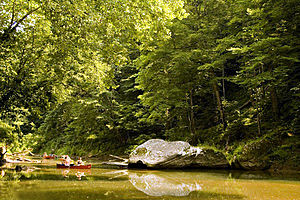I'm not sure what information you're referencing but
Phoxinus erythrogaster Southern Redbelly Dace are native to KY. I also agree with Matt, your fish appears to be SRBD.
Lots of odd stuff in this topic. I can only try to support what Matt is saying (I'm with him %100). If you're unsure of the ID of a fish, it's only logical to snap a quick photo at the waters edge and immediately release the fish. This will allow you to get the correct ID while at the same time preventing any harm to possibly protected fish. In time you'll have a better handle on ID and books are a great way to start. Books will help with ID, natural ranges and information on the fishes preferred habitat.
Returning fish, moving fish or playing "Johnny Appleseed" as Matt indicated is the opposite of what sound and responsible behavior should be. Please take a look at the
NANFA code of ethics . This is great set of rules that we can all live by. I'll post the text below as a refresher.
NANFA Member Code of EthicsNANFA Members who collect native fishes from the wild and maintain them in private aquaria are encouraged to comply with the following Code of Ethics:
* It is the responsibility of NANFA members to acquaint themselves with, and abide by, the collecting, fishing and fish transfer regulations of each Country, State or Province in which they collect, transfer, or ship fish.
* Collecting must be done in an environmentally sound and responsible manner, which includes, but is not limited to: a) not removing numbers of fishes beyond that which one requires or is capable of sustaining; b) taking all reasonable actions to prevent negative impacts on the habitat in which one collects; c) respecting private property rights; and d) complying with any law-enforcement, natural-resource, or other conservation officer or agent encountered in the field.
* NANFA members who enjoy collecting and maintaining fishes do so of their own accord. Except for specific programs funded and/or sponsored by the Association, NANFA does not sanction any specific collection and/or captive maintenance of native fishes.
* Not all native fishes are suitable for aquaria, and some species may test the skills of even the most experienced aquarist. Therefore, members are encouraged to research the biology and captive requirements of each species before an attempt is made to remove them from the wild.
* Fishes or other aquatic organisms must not be relocated or introduced into any outdoor bodies of water, even to places where they were originally collected (except catch and immediate release), including specimens raised in private aquaria, without permission from the appropriate governing agency. Members must realize that there are complicated and often unknown ecological processes at work in aquatic systems which may make fish introductions detrimental to the system. Potential problems from such introductions include displacement of native species, spread of disease, and the loss of genetic diversity via hybridization.
* All reasonable attempts should be made to maintain fishes with the utmost regard for their safety and health, which includes, but is not limited to: maintaining sufficient water quality; providing water chemistry, temperature, oxygen levels and foods appropriate for each particular species; species compatibility; and the safe and humane transport of fishes from the wild to the aquarium. Sick or infirm specimens should be euthanized in a humane manner and disposed of properly.
 group1.jpg 19.74KB
1 downloads
group1.jpg 19.74KB
1 downloads yellow_fin1.jpg 17.5KB
1 downloads
yellow_fin1.jpg 17.5KB
1 downloads









